-

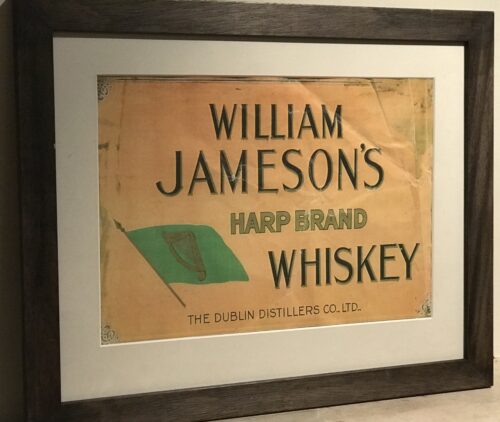 44cm x 55cm Dublin The Marrowbone Lane Distillery was an Irish whiskey distillery located on Marrowbone Lane, in Dublin, Ireland. One of the "big four" historical Dublin whiskey firms, it was run by William Jameson, a member of the Jameson whiskey dynasty. However, the whiskey now known as Jameson Irish Whiskey was not produced at this distillery, but at the separate enterprise run by John Jameson at the nearby Bow Street Distillery. The distillery closed in 1923 following financial difficulties.The precise origins of the distillery are uncertain, however, it was likely established in the 1750s (possibly 1752) and later acquired by the Stein family, relatives of the Jameson family circa 1780. An excise return in 1802 lists Stein and Jameson, however, by 1822 the company had become William Jameson & Co. Initially a small undertaking, with an output of just 30,000 gallons per annum, the distillery expanded over time, and by the time Alfred Barnard, a British historian visited the distillery in the 1880s, it had grown to cover some 14 acres. In his book, The Whisky Distilleries of the United Kingdom, Barnard described Marrowbone Lane as having some of the biggest distilling equipment in the world, including two mash tuns with capacities in excess of 100,000 gallons, which were the "said to be the largest in the United Kingdom". At its peak, the distillery was the second largest in Dublin (then one of the world's largest whiskey distilling centres), with an output of 900,000 gallons per annum, and a staff of 200, including 30 coopers. The whiskey produced at the distillery, known as "Dublin Whiskey" was chiefly exported to Australia, Canada, India and the United States. Later renamed the Dublin Distilling Company, the company entered financial difficulties in the late 1800s, and in 1891, merged with George Roe's Thomas Street Distillery and the Dublin Whiskey Distillery Company's Jones Road Distillery to form the Dublin Distilleries Company Ltd. Although, the amalgamated company had a potential production capacity of 3.5 million gallons per annum, it continued to endure severe financial difficulties, in particular, following the loss of both the American and British Commonwealth export markets during prohibition and the Anglo-Irish trade war in the 1920s. Both the Thomas Street and Marrowbone Lane distilleries closed in 1923, with the Jones Road Distillery following suit in 1926. Though distilling may have continued at Jones Road until 1946. During the 1916 Easter uprising, both the Marrowbone Lane distillery and Roe's distillery at Thomas Street were used as strongpoints by a force of more than a hundred rebels.
44cm x 55cm Dublin The Marrowbone Lane Distillery was an Irish whiskey distillery located on Marrowbone Lane, in Dublin, Ireland. One of the "big four" historical Dublin whiskey firms, it was run by William Jameson, a member of the Jameson whiskey dynasty. However, the whiskey now known as Jameson Irish Whiskey was not produced at this distillery, but at the separate enterprise run by John Jameson at the nearby Bow Street Distillery. The distillery closed in 1923 following financial difficulties.The precise origins of the distillery are uncertain, however, it was likely established in the 1750s (possibly 1752) and later acquired by the Stein family, relatives of the Jameson family circa 1780. An excise return in 1802 lists Stein and Jameson, however, by 1822 the company had become William Jameson & Co. Initially a small undertaking, with an output of just 30,000 gallons per annum, the distillery expanded over time, and by the time Alfred Barnard, a British historian visited the distillery in the 1880s, it had grown to cover some 14 acres. In his book, The Whisky Distilleries of the United Kingdom, Barnard described Marrowbone Lane as having some of the biggest distilling equipment in the world, including two mash tuns with capacities in excess of 100,000 gallons, which were the "said to be the largest in the United Kingdom". At its peak, the distillery was the second largest in Dublin (then one of the world's largest whiskey distilling centres), with an output of 900,000 gallons per annum, and a staff of 200, including 30 coopers. The whiskey produced at the distillery, known as "Dublin Whiskey" was chiefly exported to Australia, Canada, India and the United States. Later renamed the Dublin Distilling Company, the company entered financial difficulties in the late 1800s, and in 1891, merged with George Roe's Thomas Street Distillery and the Dublin Whiskey Distillery Company's Jones Road Distillery to form the Dublin Distilleries Company Ltd. Although, the amalgamated company had a potential production capacity of 3.5 million gallons per annum, it continued to endure severe financial difficulties, in particular, following the loss of both the American and British Commonwealth export markets during prohibition and the Anglo-Irish trade war in the 1920s. Both the Thomas Street and Marrowbone Lane distilleries closed in 1923, with the Jones Road Distillery following suit in 1926. Though distilling may have continued at Jones Road until 1946. During the 1916 Easter uprising, both the Marrowbone Lane distillery and Roe's distillery at Thomas Street were used as strongpoints by a force of more than a hundred rebels. -
 William Jameson Whisky Advert from the Cork Industrial Exhibition Programme in 1883. 30cm x 45cm Dublin William Jameson & Co (Marrowbone Lane Distillery) was an Irish whiskey distillery located on Marrowbone Lane, in Dublin, Ireland. One of the "big four" historical Dublin whiskey firms, it was run by William Jameson, a member of the Jameson whiskey dynasty. However, the whiskey now known as Jameson Irish Whiskey was not produced at this distillery, but at the separate enterprise run by John Jameson at the nearby Bow Street Distillery. The distillery closed in 1923 following financial difficulties.The precise origins of the distillery are uncertain, however, it was likely established in the 1750s (possibly 1752) and later acquired by the Stein family, relatives of the Jameson family circa 1780. An excise return in 1802 lists Stein and Jameson, however, by 1822 the company had become William Jameson & Co. Initially a small undertaking, with an output of just 30,000 gallons per annum, the distillery expanded over time, and by the time Alfred Barnard, a British historian visited the distillery in the 1880s, it had grown to cover some 14 acres.In his book, The Whisky Distilleries of the United Kingdom, Barnard described Marrowbone Lane as having some of the biggest distilling equipment in the world, including two mash tuns with capacities in excess of 100,000 gallons, which were the "said to be the largest in the United Kingdom". At its peak, the distillery was the second largest in Dublin (then one of the world's largest whiskey distilling centres), with an output of 900,000 gallons per annum, and a staff of 200, including 30 coopers. The whiskey produced at the distillery, known as "Dublin Whiskey" was chiefly exported to Australia, Canada, India and the United States. Later renamed the Dublin Distilling Company, the company entered financial difficulties in the late 1800s, and in 1891, merged with George Roe's Thomas Street Distillery and the Dublin Whiskey Distillery Company's Jones Road Distillery to form the Dublin Distilleries Company Ltd. Although, the amalgamated company had a potential production capacity of 3.5 million gallons per annum, it continued to endure severe financial difficulties, in particular, following the loss of both the American and British Commonwealth export markets during prohibition and the Anglo-Irish trade war in the 1920s. Both the Thomas Street and Marrowbone Lane distilleries closed in 1923, with the Jones Road Distillery following suit in 1926. Though distilling may have continued at Jones Road until 1946. During the 1916 Easter uprising, both the Marrowbone Lane distillery and Roe's distillery at Thomas Street were used as strongpoints by a force of more than a hundred rebels.
William Jameson Whisky Advert from the Cork Industrial Exhibition Programme in 1883. 30cm x 45cm Dublin William Jameson & Co (Marrowbone Lane Distillery) was an Irish whiskey distillery located on Marrowbone Lane, in Dublin, Ireland. One of the "big four" historical Dublin whiskey firms, it was run by William Jameson, a member of the Jameson whiskey dynasty. However, the whiskey now known as Jameson Irish Whiskey was not produced at this distillery, but at the separate enterprise run by John Jameson at the nearby Bow Street Distillery. The distillery closed in 1923 following financial difficulties.The precise origins of the distillery are uncertain, however, it was likely established in the 1750s (possibly 1752) and later acquired by the Stein family, relatives of the Jameson family circa 1780. An excise return in 1802 lists Stein and Jameson, however, by 1822 the company had become William Jameson & Co. Initially a small undertaking, with an output of just 30,000 gallons per annum, the distillery expanded over time, and by the time Alfred Barnard, a British historian visited the distillery in the 1880s, it had grown to cover some 14 acres.In his book, The Whisky Distilleries of the United Kingdom, Barnard described Marrowbone Lane as having some of the biggest distilling equipment in the world, including two mash tuns with capacities in excess of 100,000 gallons, which were the "said to be the largest in the United Kingdom". At its peak, the distillery was the second largest in Dublin (then one of the world's largest whiskey distilling centres), with an output of 900,000 gallons per annum, and a staff of 200, including 30 coopers. The whiskey produced at the distillery, known as "Dublin Whiskey" was chiefly exported to Australia, Canada, India and the United States. Later renamed the Dublin Distilling Company, the company entered financial difficulties in the late 1800s, and in 1891, merged with George Roe's Thomas Street Distillery and the Dublin Whiskey Distillery Company's Jones Road Distillery to form the Dublin Distilleries Company Ltd. Although, the amalgamated company had a potential production capacity of 3.5 million gallons per annum, it continued to endure severe financial difficulties, in particular, following the loss of both the American and British Commonwealth export markets during prohibition and the Anglo-Irish trade war in the 1920s. Both the Thomas Street and Marrowbone Lane distilleries closed in 1923, with the Jones Road Distillery following suit in 1926. Though distilling may have continued at Jones Road until 1946. During the 1916 Easter uprising, both the Marrowbone Lane distillery and Roe's distillery at Thomas Street were used as strongpoints by a force of more than a hundred rebels. -

 44cm x 34cm Dublin The Marrowbone Lane Distillery was an Irish whiskey distillery located on Marrowbone Lane, in Dublin, Ireland. One of the "big four" historical Dublin whiskey firms, it was run by William Jameson, a member of the Jameson whiskey dynasty. However, the whiskey now known as Jameson Irish Whiskey was not produced at this distillery, but at the separate enterprise run by John Jameson at the nearby Bow Street Distillery. The distillery closed in 1923 following financial difficulties.The precise origins of the distillery are uncertain, however, it was likely established in the 1750s (possibly 1752) and later acquired by the Stein family, relatives of the Jameson family circa 1780. An excise return in 1802 lists Stein and Jameson, however, by 1822 the company had become William Jameson & Co. Initially a small undertaking, with an output of just 30,000 gallons per annum, the distillery expanded over time, and by the time Alfred Barnard, a British historian visited the distillery in the 1880s, it had grown to cover some 14 acres. In his book, The Whisky Distilleries of the United Kingdom, Barnard described Marrowbone Lane as having some of the biggest distilling equipment in the world, including two mash tuns with capacities in excess of 100,000 gallons, which were the "said to be the largest in the United Kingdom". At its peak, the distillery was the second largest in Dublin (then one of the world's largest whiskey distilling centres), with an output of 900,000 gallons per annum, and a staff of 200, including 30 coopers. The whiskey produced at the distillery, known as "Dublin Whiskey" was chiefly exported to Australia, Canada, India and the United States. Later renamed the Dublin Distilling Company, the company entered financial difficulties in the late 1800s, and in 1891, merged with George Roe's Thomas Street Distillery and the Dublin Whiskey Distillery Company's Jones Road Distillery to form the Dublin Distilleries Company Ltd. Although, the amalgamated company had a potential production capacity of 3.5 million gallons per annum, it continued to endure severe financial difficulties, in particular, following the loss of both the American and British Commonwealth export markets during prohibition and the Anglo-Irish trade war in the 1920s. Both the Thomas Street and Marrowbone Lane distilleries closed in 1923, with the Jones Road Distillery following suit in 1926. Though distilling may have continued at Jones Road until 1946. During the 1916 Easter uprising, both the Marrowbone Lane distillery and Roe's distillery at Thomas Street were used as strongpoints by a force of more than a hundred rebels.
44cm x 34cm Dublin The Marrowbone Lane Distillery was an Irish whiskey distillery located on Marrowbone Lane, in Dublin, Ireland. One of the "big four" historical Dublin whiskey firms, it was run by William Jameson, a member of the Jameson whiskey dynasty. However, the whiskey now known as Jameson Irish Whiskey was not produced at this distillery, but at the separate enterprise run by John Jameson at the nearby Bow Street Distillery. The distillery closed in 1923 following financial difficulties.The precise origins of the distillery are uncertain, however, it was likely established in the 1750s (possibly 1752) and later acquired by the Stein family, relatives of the Jameson family circa 1780. An excise return in 1802 lists Stein and Jameson, however, by 1822 the company had become William Jameson & Co. Initially a small undertaking, with an output of just 30,000 gallons per annum, the distillery expanded over time, and by the time Alfred Barnard, a British historian visited the distillery in the 1880s, it had grown to cover some 14 acres. In his book, The Whisky Distilleries of the United Kingdom, Barnard described Marrowbone Lane as having some of the biggest distilling equipment in the world, including two mash tuns with capacities in excess of 100,000 gallons, which were the "said to be the largest in the United Kingdom". At its peak, the distillery was the second largest in Dublin (then one of the world's largest whiskey distilling centres), with an output of 900,000 gallons per annum, and a staff of 200, including 30 coopers. The whiskey produced at the distillery, known as "Dublin Whiskey" was chiefly exported to Australia, Canada, India and the United States. Later renamed the Dublin Distilling Company, the company entered financial difficulties in the late 1800s, and in 1891, merged with George Roe's Thomas Street Distillery and the Dublin Whiskey Distillery Company's Jones Road Distillery to form the Dublin Distilleries Company Ltd. Although, the amalgamated company had a potential production capacity of 3.5 million gallons per annum, it continued to endure severe financial difficulties, in particular, following the loss of both the American and British Commonwealth export markets during prohibition and the Anglo-Irish trade war in the 1920s. Both the Thomas Street and Marrowbone Lane distilleries closed in 1923, with the Jones Road Distillery following suit in 1926. Though distilling may have continued at Jones Road until 1946. During the 1916 Easter uprising, both the Marrowbone Lane distillery and Roe's distillery at Thomas Street were used as strongpoints by a force of more than a hundred rebels. -

 42cm x 32cm LimerickThomas Power (1856-1930) was the first chairman of Waterford County Council and was chairman of Dungarvan Town Commissioners on a number of occasions. In the 1880s he was in partnership with his brother producing mineral waters. In 1904 he began producing his award winning Blackwater Cider. In 1917 Thomas purchased the old St Brigid's Well Brewery in Fair Lane, Dungarvan from the Marquis of Waterford. The business was a great success and its produce was in demand all over County Waterford and beyond. After his death the brewery was taken over by his son Paul I. Power who managed it until 1976 when his son Ion took over. Brewing took place in Dungarvan throughout history but we only have detailed information from the late 18th century onwards. In 1917 the Marquis sold the property and it was acquired by Thomas Power. He developed a thriving business known as Power's Brewery. This brewing tradition continues into the modern era with the Dungarvan Brewing Company.
42cm x 32cm LimerickThomas Power (1856-1930) was the first chairman of Waterford County Council and was chairman of Dungarvan Town Commissioners on a number of occasions. In the 1880s he was in partnership with his brother producing mineral waters. In 1904 he began producing his award winning Blackwater Cider. In 1917 Thomas purchased the old St Brigid's Well Brewery in Fair Lane, Dungarvan from the Marquis of Waterford. The business was a great success and its produce was in demand all over County Waterford and beyond. After his death the brewery was taken over by his son Paul I. Power who managed it until 1976 when his son Ion took over. Brewing took place in Dungarvan throughout history but we only have detailed information from the late 18th century onwards. In 1917 the Marquis sold the property and it was acquired by Thomas Power. He developed a thriving business known as Power's Brewery. This brewing tradition continues into the modern era with the Dungarvan Brewing Company. -
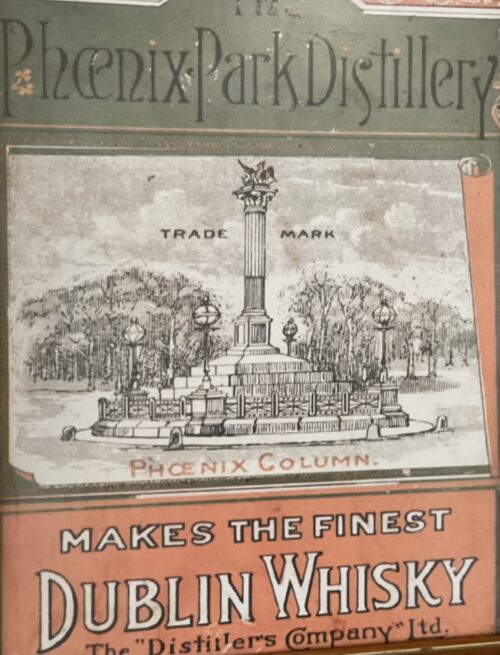
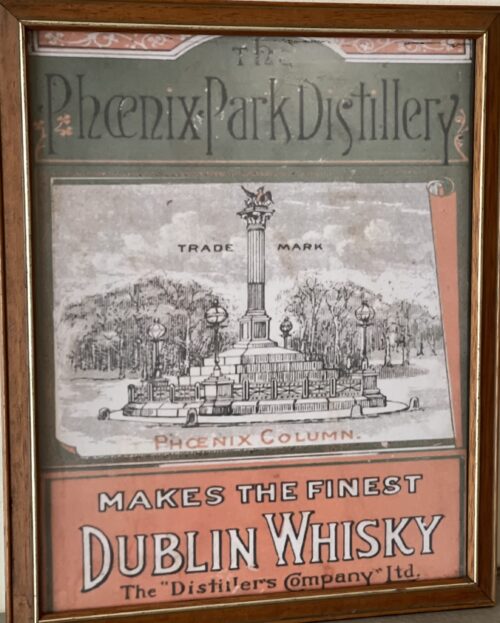 40cm x 34cm Limerick
40cm x 34cm LimerickThe Distillery in Chapelizod, near Dublin's Phoenix Park, was converted from an old mill in 1878 by the Distillers' Company, Ltd., of Scotland, who later went on to become the biggest player in Scotch Whisky owning brands such as Haig, Dewar's, and Buchanan's, as well as countless Malt and Grain Distilleries in Scotland, until the group was taken over by Guinness in the 1980s.
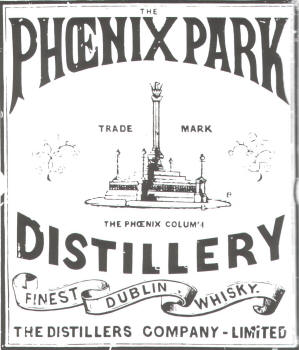 Old Advertisement for Phoenix Park Distillery
Old Advertisement for Phoenix Park DistilleryIt seemed profitable to own an Irish Distillery in those days: Dublin Whiskey, being considered the finest in the world, was priced 25 per cent higher than comparable Scotch Whisky.
The production of Phoenix Park Distillery, 350,000 gallons (1.5 Million Litres) per year, was sold to England and its colonies, as well as used for blending with DCL's own Scottish Malt and Grain Whiskies.
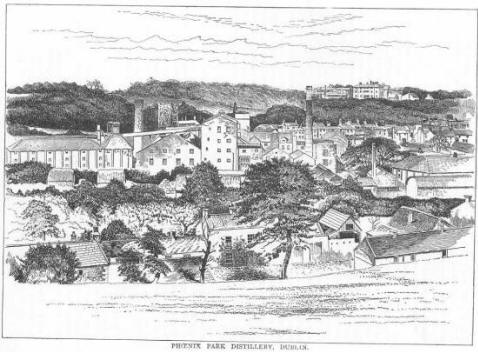 DCL's Phoenix Park Distillery in 1886
DCL's Phoenix Park Distillery in 1886However, Phoenix Park Distillery had only a short life span. Production ceased in 1921, and DCL abandoned the plant a few years later, due to the politically and commercially difficult situation in Ireland at the time.
Today, most buildings have survived, including the mill lade, once holding the largest water wheel in the UK. Others have been converted into apartment houses.
-

 65cm x 45cm Nun's Island Distillery was an Irish whiskey distillery which operated in Galway, Ireland, from at least 1815, and possibly as early as the late 1700s, until circa 1908. At its peak, in the late 1800s, output at the distillery reached 400,000 gallons per annum, and with a workforce of over 100, the distillery was one of the largest local employers. Owned by the Persse family from the 1840s onwards, the distillery produced single pot still whiskey known as Persse's Galway Whiskey. The whiskey was sold locally in Connacht, where for much of the 1800s, Nun's Island was the only licensed distillery.However, it was also exported, and is said to have been a sold to the British House of Commons, a fact proudly noted on their labels. Production at the distillery ceased circa 1908, with the remaining stocks wound down off over several few years. A bottle of Persse's whiskey was placed for auction in 2002 with a reserve price of £100,000 - however, it failed to sell. The bottle later sold for £3,300 in 2014.
65cm x 45cm Nun's Island Distillery was an Irish whiskey distillery which operated in Galway, Ireland, from at least 1815, and possibly as early as the late 1700s, until circa 1908. At its peak, in the late 1800s, output at the distillery reached 400,000 gallons per annum, and with a workforce of over 100, the distillery was one of the largest local employers. Owned by the Persse family from the 1840s onwards, the distillery produced single pot still whiskey known as Persse's Galway Whiskey. The whiskey was sold locally in Connacht, where for much of the 1800s, Nun's Island was the only licensed distillery.However, it was also exported, and is said to have been a sold to the British House of Commons, a fact proudly noted on their labels. Production at the distillery ceased circa 1908, with the remaining stocks wound down off over several few years. A bottle of Persse's whiskey was placed for auction in 2002 with a reserve price of £100,000 - however, it failed to sell. The bottle later sold for £3,300 in 2014.History
The early history of the distillery is somewhat difficult to piece together.It is known that a distillery on Nun's Island was being operated on by a John Joyce in the late 1700s.This distillery, which was subsequently taken over by Patrick Joyce, is thought to have ceased operations in 1807. A Patrick Joyce is recorded as running a small distillery on Nun's Island again in 1823. Therefore, it is possible that the closure was temporary. By 1828, output at the distillery had increased to 130,000 proof gallons per annum. There are claims that the distillery ceased operations again in the late 1830s.However, a newspaper advertisement from 1841 reports that a distillery "lately occupied and worked" by Messrs. James and Patrick Joyce was to be sold on 4 February 1841. The advertisement noted that the distillery was held under a 300-year lease, which had commenced in August 1815.This tallies with Alfred Barnard's 1887 report that Joyce's owned the distillery from 1815 to 1840. In about 1840 or 1841, the distillery was purchased by the Persses, a local family who ran several other distilleries in the area.There is some conflicting information with regard to the precise and nature of the sale date. Barnard reported that the distillery was sold by the Encumbered Claims Courts in 1840.However, a newspaper article from the era reports that the distillery was to be sold by private contract in February 1841. As Barnard mentions that the Persses enlarged the original operation, the confusion may be due to piecemeal purchases of different sections of the site, or delays in finalising the sale as the distillery had been repeatedly advertised for sale beginning in at least early 1840. Initially the Persses converted the distillery to a woollen mill, which was known for producing excellent friezes. However, when their lease on the nearby Newcastle Distillery expired in 1846, they moved their distilling operations at the Nun's Island complex, and re-established the site as a distillery. In 1886, the distillery was visited by British historian Alfred Barnard, as recounted in his seminal publication "The Whiskey Distilleries of the United Kingdom". Barnard noted that at the time of his visit Nun's Island was the sole distillery operating in Connacht, and had an output of about 400,000 gallons per annum. In addition to offices, workshops, stables, and storehouses, the distillery buildings included two lofty Maltings and Corn stores built of stone, five storeys of which were devoted to the storing of corn, and two to malting purposes; an elegant brew house equal to any in Ireland; a back house containing thirteen washbacks, each with a capacity of about 18,000 gallons; a still house containing a 16,000 gallon wash still, a 10,000 gallon spirit still, and a 6,000 gallon low-wines still; a spirit store occupied by a 12,000 gallon vat; and five warehouses, holding a total of about 5,000 casks at the time. Like many other Irish distilleries, Nun's Island encountered financial difficulties during the early part of the 20th Century, is thought to have closed shortly before World War I. Since closing, some of the distillery complex has been demolished. However, several of the main distillery buildings, notably the large riverside warehouse, are still extant. -

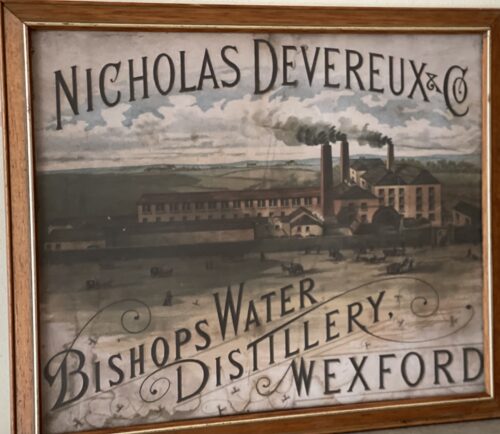 40cm x 34cm LimerickBishops Water Distillery(subsequently known as Nicholas Devereux Finest Irish Whisky) was an Irish whiskey distillery which operated in Wexford, Ireland between 1827 and 1914. The distillery was named for a stream which ran along the back of the distillery, the Bishop's Water, said to possess "various occult properties derived from the blessings of the sainted Bishop of Ferns". Constructed at a cost of £30,000, the distillery was reported to be “reckoned the most perfect and complete of the kind in Ireland”.In 1833, just a few years after it opened, the distillery recorded an output of about 200,000 gallons per annum .However, output had fallen to just 110,000 gallons per annum in 1886, when the distillery was visited by Alfred Barnard, as recorded in his seminal 1887 publication "The Whisky Distilleries of the United Kingdom". This was amongst the lowest output of any distillery operating in Ireland at the time, and far below the potential output of 250,000 gallons per annum reported when the distillery was offered for sale as a going concern in 1909. The distillery's whiskey, Barnard noted, was highly appreciated locally, and in the British cities where it was exported. In the early 20th century, with the Irish whiskey industry in decline, Bishop's Water distillery, like the majority of distilleries in Ireland at the time, suffered serious financial difficulties, and entered bankruptcy. Following its closure, the distillery was initially converted into an iron works (Pierce Ironworks). However, much of the site was later demolished, and little evidence of the distillery still remains. Some mementos can still be found in locals pubs, while a stone archway known to have been extant in 1903 and now bearing the inscription "Casa Rio", possibly in reference to the location of a Pierce ironworks office in Buenos Aires, marks the entrance to the site where the distillery once stood, on Distillery Road. In 1827, a whiskey distillery was established on what is now Distillery Road, Wexford by a consortium of businessmen. The consortium which traded under "Devereux, Harvey, and Co., Distillers", comprised a number of local businessmen, including Nicholas Devereux, his father John Devereux, and Maurice Crosbie Harvey. John Devereux had previously operated a small distillery in the area in the late 1700s, but will little success. In 1830, one of the partners, Maurice Harvey, was accidentally killed at the distillery by an excise man who was taking aim at some birds flying overhead. A few years later, in 1836, the partnership was dissolved at the mutual consent of the remaining partners, with Nicholas Devereux taking sole ownership of the distillery, after which the distillery traded under the name Nicholas Devereux & Son.On his death in 1840, operation of the distillery was taken over by his son Richard. Nichloas Devereux's granddaughter, Mary Anne Therese was also deeply involving in the distilling industry. She married John Locke, founder of the larger Kilbeggan distillery, and successfully took over the business operations of the distillery on his death in 1868. According to Alfred Barnard, the British journalist who visited Bishop's Water in the 1880s, the distillery produced triple-distilled "old pot still whiskey", which was sold locally in Ireland, and also exported to London, Liverpool, and Bristol. At the time of his visit, the Malt Warehouses on-site contained over 16,000 barrels of pure malt. In addition, upwards of 3,000 casks of whiskey were undergoing maturation at the distillery. Whiskey from the distillery is also noted to have been used in the production of blended whiskeys in later years. In the early 20th century, the distillery suffered financial difficulties. In 1907, an attempt was made to appoint a receiver, and in 1909, the distillery was put up for sale, but no takers could be found.In 1914, distilling eventually ceased at the site, and the remaining stocks were sold off.
40cm x 34cm LimerickBishops Water Distillery(subsequently known as Nicholas Devereux Finest Irish Whisky) was an Irish whiskey distillery which operated in Wexford, Ireland between 1827 and 1914. The distillery was named for a stream which ran along the back of the distillery, the Bishop's Water, said to possess "various occult properties derived from the blessings of the sainted Bishop of Ferns". Constructed at a cost of £30,000, the distillery was reported to be “reckoned the most perfect and complete of the kind in Ireland”.In 1833, just a few years after it opened, the distillery recorded an output of about 200,000 gallons per annum .However, output had fallen to just 110,000 gallons per annum in 1886, when the distillery was visited by Alfred Barnard, as recorded in his seminal 1887 publication "The Whisky Distilleries of the United Kingdom". This was amongst the lowest output of any distillery operating in Ireland at the time, and far below the potential output of 250,000 gallons per annum reported when the distillery was offered for sale as a going concern in 1909. The distillery's whiskey, Barnard noted, was highly appreciated locally, and in the British cities where it was exported. In the early 20th century, with the Irish whiskey industry in decline, Bishop's Water distillery, like the majority of distilleries in Ireland at the time, suffered serious financial difficulties, and entered bankruptcy. Following its closure, the distillery was initially converted into an iron works (Pierce Ironworks). However, much of the site was later demolished, and little evidence of the distillery still remains. Some mementos can still be found in locals pubs, while a stone archway known to have been extant in 1903 and now bearing the inscription "Casa Rio", possibly in reference to the location of a Pierce ironworks office in Buenos Aires, marks the entrance to the site where the distillery once stood, on Distillery Road. In 1827, a whiskey distillery was established on what is now Distillery Road, Wexford by a consortium of businessmen. The consortium which traded under "Devereux, Harvey, and Co., Distillers", comprised a number of local businessmen, including Nicholas Devereux, his father John Devereux, and Maurice Crosbie Harvey. John Devereux had previously operated a small distillery in the area in the late 1700s, but will little success. In 1830, one of the partners, Maurice Harvey, was accidentally killed at the distillery by an excise man who was taking aim at some birds flying overhead. A few years later, in 1836, the partnership was dissolved at the mutual consent of the remaining partners, with Nicholas Devereux taking sole ownership of the distillery, after which the distillery traded under the name Nicholas Devereux & Son.On his death in 1840, operation of the distillery was taken over by his son Richard. Nichloas Devereux's granddaughter, Mary Anne Therese was also deeply involving in the distilling industry. She married John Locke, founder of the larger Kilbeggan distillery, and successfully took over the business operations of the distillery on his death in 1868. According to Alfred Barnard, the British journalist who visited Bishop's Water in the 1880s, the distillery produced triple-distilled "old pot still whiskey", which was sold locally in Ireland, and also exported to London, Liverpool, and Bristol. At the time of his visit, the Malt Warehouses on-site contained over 16,000 barrels of pure malt. In addition, upwards of 3,000 casks of whiskey were undergoing maturation at the distillery. Whiskey from the distillery is also noted to have been used in the production of blended whiskeys in later years. In the early 20th century, the distillery suffered financial difficulties. In 1907, an attempt was made to appoint a receiver, and in 1909, the distillery was put up for sale, but no takers could be found.In 1914, distilling eventually ceased at the site, and the remaining stocks were sold off. -
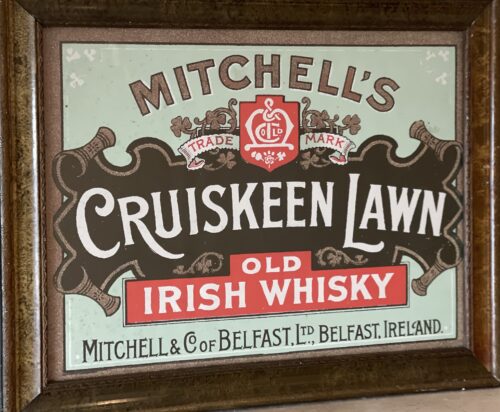
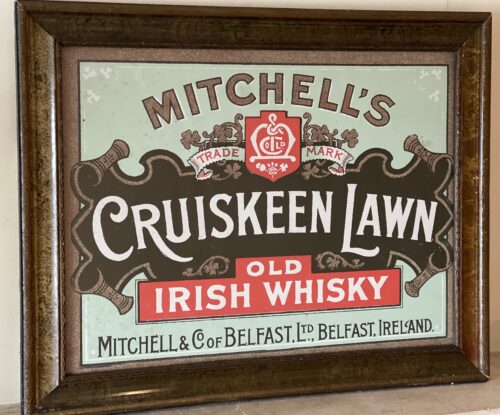 Mitchells Cruiskeen Lawn Old Irish Whiskey Advert. 48cm x 60cm Coleraine Co Antrim Once a giant of the distilling business along with Dunvilles,Mitchell’s fall from grace, like so many other superb Irish distilleries was symptomatic of the economic climate and circumstances of the time. Charles William Mitchell originated from Scotland and took over his fathers distillery in the Campletown area .In the 1860s he moved to Belfast and became manager of Dunvilles Whiskey before establishing his own brand Mitchell & Co tomb St in the late 1860s.A newspaper report in 1895 hailed the virtues of Mitchells Cruiskeen Lawn Whisky,which secured prizes around the world including first place at the New Orleans Exposition.It was a rare Mitchells Cruiskeen Lawn Whiskey mirror that recently commanded £11500 at auction in 2018 following the sale of the contents of an old Donegal public house. Indeed Mitchell’s were renowned for advertising their products on mirrors, trade cards, minature atlas books and pottery to name just a few. Below is the original mirror that was commissioned for their Tomb Street premises on the launch of their Cruiskeen Lawn Old Irish Whisky, late 1800’s. Two were made for the entrance of their Tomb Street premises. Inscribed is the Cruiskeen Lawn poem, with gold leaf barley with green and red in the Mitchell Crest. Definately the holy grail of all mirrors, a true treasure and still survives today in the heart of Belfast and worth the above mentioned princely sum and now probably more !
Mitchells Cruiskeen Lawn Old Irish Whiskey Advert. 48cm x 60cm Coleraine Co Antrim Once a giant of the distilling business along with Dunvilles,Mitchell’s fall from grace, like so many other superb Irish distilleries was symptomatic of the economic climate and circumstances of the time. Charles William Mitchell originated from Scotland and took over his fathers distillery in the Campletown area .In the 1860s he moved to Belfast and became manager of Dunvilles Whiskey before establishing his own brand Mitchell & Co tomb St in the late 1860s.A newspaper report in 1895 hailed the virtues of Mitchells Cruiskeen Lawn Whisky,which secured prizes around the world including first place at the New Orleans Exposition.It was a rare Mitchells Cruiskeen Lawn Whiskey mirror that recently commanded £11500 at auction in 2018 following the sale of the contents of an old Donegal public house. Indeed Mitchell’s were renowned for advertising their products on mirrors, trade cards, minature atlas books and pottery to name just a few. Below is the original mirror that was commissioned for their Tomb Street premises on the launch of their Cruiskeen Lawn Old Irish Whisky, late 1800’s. Two were made for the entrance of their Tomb Street premises. Inscribed is the Cruiskeen Lawn poem, with gold leaf barley with green and red in the Mitchell Crest. Definately the holy grail of all mirrors, a true treasure and still survives today in the heart of Belfast and worth the above mentioned princely sum and now probably more ! -

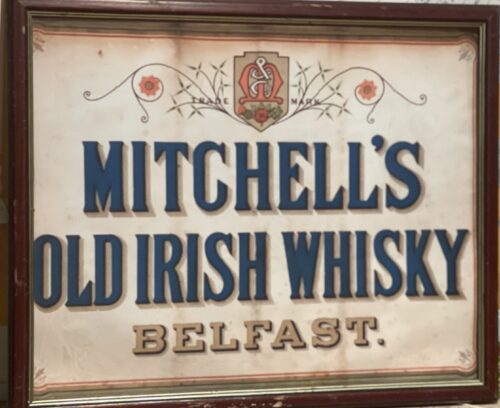 44cm x 65cm Once a giant of the distilling business along with Dunvilles,Mitchell’s fall from grace, like so many other superb Irish distilleries was symptomatic of the economic climate and circumstances of the time. Charles William Mitchell originated from Scotland and took over his fathers distillery in the Campletown area .In the 1860s he moved to Belfast and became manager of Dunvilles Whiskey before establishing his own brand Mitchell & Co tomb St in the late 1860s.A newspaper report in 1895 hailed the virtues of Mitchells Cruiskeen Lawn Whisky,which secured prizes around the world including first place at the New Orleans Exposition.It was a rare Mitchells Cruiskeen Lawn Whiskey mirror that recently commanded £11500 at auction in 2018 following the sale of the contents of an old Donegal public house. Indeed Mitchell’s were renowned for advertising their products on mirrors, trade cards, minature atlas books and pottery to name just a few. Below is the original mirror that was commissioned for their Tomb Street premises on the launch of their Cruiskeen Lawn Old Irish Whisky, late 1800’s. Two were made for the entrance of their Tomb Street premises. Inscribed is the Cruiskeen Lawn poem, with gold leaf barley with green and red in the Mitchell Crest. Definately the holy grail of all mirrors, a true treasure and still survives today in the heart of Belfast and worth the above mentioned princely sum and now probably more !
44cm x 65cm Once a giant of the distilling business along with Dunvilles,Mitchell’s fall from grace, like so many other superb Irish distilleries was symptomatic of the economic climate and circumstances of the time. Charles William Mitchell originated from Scotland and took over his fathers distillery in the Campletown area .In the 1860s he moved to Belfast and became manager of Dunvilles Whiskey before establishing his own brand Mitchell & Co tomb St in the late 1860s.A newspaper report in 1895 hailed the virtues of Mitchells Cruiskeen Lawn Whisky,which secured prizes around the world including first place at the New Orleans Exposition.It was a rare Mitchells Cruiskeen Lawn Whiskey mirror that recently commanded £11500 at auction in 2018 following the sale of the contents of an old Donegal public house. Indeed Mitchell’s were renowned for advertising their products on mirrors, trade cards, minature atlas books and pottery to name just a few. Below is the original mirror that was commissioned for their Tomb Street premises on the launch of their Cruiskeen Lawn Old Irish Whisky, late 1800’s. Two were made for the entrance of their Tomb Street premises. Inscribed is the Cruiskeen Lawn poem, with gold leaf barley with green and red in the Mitchell Crest. Definately the holy grail of all mirrors, a true treasure and still survives today in the heart of Belfast and worth the above mentioned princely sum and now probably more ! -

 24cm x 40cm The original company was founded in Belfast by Archibald Kirker and William Greer in 1885. From their bonded warehouse on Academy St. in the heart of Belfast they sourced and blended the best of Irish Whiskey. The Shamrock Irish Whiskey was one such blend.They went on to found the Connswater distillery and became one of ireland’s largest exporters.
24cm x 40cm The original company was founded in Belfast by Archibald Kirker and William Greer in 1885. From their bonded warehouse on Academy St. in the heart of Belfast they sourced and blended the best of Irish Whiskey. The Shamrock Irish Whiskey was one such blend.They went on to found the Connswater distillery and became one of ireland’s largest exporters. -

 Locke's Old Kilbeggan Pure Pot Still Whiskey Advert Origins: Kilbeggan Co Westmeath Dimensions: 32cm x 37cm The Kilbeggan Distillery (formerly Brusna Distillery and Locke's Distillery) is an Irish whiskey distillery situated on the River Brosna in Kilbeggan, County Westmeath, Ireland. It is owned by Beam Suntory. A small pot still distillery, the licence to distil dates to 1757, a copy of which can be seen in the distillery. Similar to many Irish distilleries, Kilbeggan endured financial difficulties during the early 20th century, and ceased operations in 1957. However, the distillery was later refurbished, with distilling recommencing on-site in 2007. Noted devotees of the distillery's whiskeys include British Prime Minister Sir Winston Churchill, and Myles na gCopaleen, the Irish playwright.
Locke's Old Kilbeggan Pure Pot Still Whiskey Advert Origins: Kilbeggan Co Westmeath Dimensions: 32cm x 37cm The Kilbeggan Distillery (formerly Brusna Distillery and Locke's Distillery) is an Irish whiskey distillery situated on the River Brosna in Kilbeggan, County Westmeath, Ireland. It is owned by Beam Suntory. A small pot still distillery, the licence to distil dates to 1757, a copy of which can be seen in the distillery. Similar to many Irish distilleries, Kilbeggan endured financial difficulties during the early 20th century, and ceased operations in 1957. However, the distillery was later refurbished, with distilling recommencing on-site in 2007. Noted devotees of the distillery's whiskeys include British Prime Minister Sir Winston Churchill, and Myles na gCopaleen, the Irish playwright.Early years
The distillery was founded in 1757 by Matthew MacManus, who may have distilled elsewhere before founding Kilbeggan.Although information about the early years of the distillery is scarce, documentation suggests that in its early years the distillery operated with a 232 gallon still, and an annual output of 1,500 gallons. By the early 19th century, the distillery was being run by a John and William Codd. In 1841, the distillery was put up for sale following the dissolution of the partnership between its then owners, William Codd and William Cuffee.The distillery at the time consisted of a brew house, still house with three pot stills (wash still: 8,000 gallons; low wine still, no. 1; 2,000 gallons; low wine still, no. 2: 1,500 gallons), run-room with five receivers, malt house, corn stores capable of storing 5,000 barrels, and oat-meal mills. Also listed in the sale were 400 tonnes of coal, and 10,000 boxes of turf - the latter reflecting the immense quantities of turf consumed at the distillery, so much so, that it was reported to have kept hundreds of poor people profitably employed in cutting, rearing, and drawing it to the town throughout the year.Locke's Distillery
In 1843, the distillery was taken over by John Locke, under whose stewardship the distillery flourished. Locke treated his staff well, and was held in high regard by both his workers and the people of the town. Informal records show that under Locke the distillery provided cottages for its employees, either for rent or purchase through a form of in-house mortgage scheme. In addition, all staff received a wagon load of coal at the start of each winter, the cost of which was deducted from salaries retrospectively on a weekly basis. Testimony of the respect with which he was held is offered by an incident in 1866. Following an accident on-site which had rendered a critical piece of equipment, the steam boiler, inoperable, the distillery had come to a standstill. With Locke unable to afford or obtain a loan to fund a replacement, the future of distillery lay in doubt.However, in a gesture of solidarity, the people of Kilbeggan came together and purchased a replacement boiler, which they presented to John Locke, along with the following public letter of appreciation, which was printed in several local newspapers at the time:An Address from the People of Kilbeggan to John Locke, Esq. Dear Sir - Permit us, your fellow townsmen, to assure of our deep and cordial sympathy in your loss and disappointment from the accident which occurred recently in your Distillery. Sincerely as we regret the accident, happily unattended with loss of life, we cannot but rejoice at the long-wished-for opportunity it affords us of testifying to you the high appreciation in which we hold you for your public and private worth. We are well aware that the restrictions imposed by recent legislation on that particular branch of Irish industry, with which you have been so long identified, have been attended with disastrous results to the trade, as is manifest in the long list of Distilleries now almost in ruins, and which were a few years ago centres of busy industry, affording remunerative employment to thousands of hands; and we are convinced the Kilbeggan Distillery would have long since swelled the dismal catalogue had it fallen into less energetic and enterprising hands. In such an event we would be compelled to witness the disheartening scene of a large number of our working population without employment during that period of the year when employment Is scarcest, and at the same time most essential to the poor. Independent then of what we owe you, on purely personal grounds, we feel we owe you a deep debt of gratitude for maintaining in our midst a manufacture which affords such extensive employment to our poor, and exercises so favourable an influence on the prosperity of the town. In conclusion, dear Sir, we beg your acceptance of a new steam boiler to replace the injured one, as testimony, inadequate though it is, of our unfeigned respect and esteems for you ; and we beg to present it with the ardent wish and earnest hope that, for many long years to come, it may contribute to enhance still more the deservedly high and increasing reputation of the Kilbeggan Distillery.
In a public response to mark the gift, also published in several newspapers, Locke thanked the people of Kilbeggan for their generosity, stating "...I feel this to be the proudest day of my life...". A plaque commemorating the event hangs in the distillery's restaurant today. In 1878, a fire broke out in the "can dip" (sampling) room of the distillery, and spread rapidly. Although, the fire was extinguished within an hour, it destroying a considerable portion of the front of the distillery and caused £400 worth of damage. Hundreds of gallons of new whiskey were also consumed in the blaze - however, the distillery is said to have been saved from further physical and financial ruin through the quick reaction of townsfolk who broke down the doors of the warehouses, and helped roll thousands of casks of ageing spirit down the street to safety. In 1887, the distillery was visited by Alfred Barnard, a British writer, as research for his book, "the Whiskey Distilleries of the United Kingdom". By then, the much enlarged distillery was being managed by John's sons, John Edward and James Harvey, who told Barnard that the distillery's output had more than doubled during the preceding ten years, and that they intended to install electric lighting.Barnard noted that the distillery, which he referred to as the "Brusna Distillery", named for the nearby river, was said to be the oldest in Ireland. According to Barnard, the distillery covered 5 acres, and employed a staff of about 70 men, with the aged and sick pensioned-off or assisted. At the time of his visit, the distillery was producing 157,200 proof gallons per annum, though it had the capacity to produce 200,000. The whiskey, which was sold primarily in Dublin, England, and "the Colonies", was "old pot still", produced using four pot stills (two wash stills: 10,320 / 8,436 gallons; and two spirit stills: 6,170 / 6,080 gallons), which had been installed by Millar and Company, Dublin. Barnard remarked that at the time of his visit over 2,000 casks of spirit were ageing in the distillery's bonded warehouses. In 1893, the distillery ceased to be privately held, and was converted a limited stock company, trading as John Locke & Co., Ltd., with nominal capital of £40,000.Decline and Closure
In the early part of the 20th century, Kilbeggan, like many Irish whiskey distilleries at the time, entered a period of decline. This was due to the combined effects of loss and hampering of market access - due to prohibition in the United States, the trade war with the British Empire, shipping difficulties during the world wars, and Irish Government export quotas; as well as competition from blended Scotch, and disruption to production during the Irish war of Independence. As a result, Kilbeggan was forced to cease production of new spirit for 7 years between 1924 and 1931, decimating the company's cash flow and finances.Most of the staff at the distillery were let go, and the distillery slowly sold off its stocks of aged whiskey. Distilling resumed in 1931, following the end of prohibition in the United States, and for a time the distillery's finances improved - with a loss of £83 in 1931, converted to a modest profit of £6,700 in 1939. In the 1920s, both of John sons passed away, John in 1920, and James in 1927, and ownership of the distillery passed to Locke's granddaughters, Mary Evelyn and Florence Emily.However, by then the distillery was in need to repair, with the turbulent economic conditions of the early 20th century having meant that no investment had been made in new plant since the 1890s. In 1947, the Lockes decided to put the distillery was put up for sale as a going concern. Although run down, the distillery had valuable stocks of mature whiskey, a valuable commodity in post-war Europe.An offer of £305,000 was received from a Swiss investor fronted by an Englishman, going by the name of Horace Smith.Their unstated interest, was not the business itself, but the 60,000 gallons of whiskey stocks, which they hoped to sell on the black market in England at £11 a gallon - thus, more than doubling their investment overnight. However, when they failed to come up with the deposit, the duo were arrested and promptly interrogated by Irish police. The Englishman, it turned out, was an impostor named Maximoe, who was wanted by Scotland Yard.]The Irish authorities placed Maximoe on a ferry back to England for extradition, but he jumped overboard and escaped with the help of unknown accomplices. An Irish opposition politician, Oliver J. Flanagan, subsequently alleged under parliamentary privilege that members of the governing Fianna Fáil political party were linked to the deal, accusing then Irish Taoiseach Éamon de Valera and his son of having accepted gold watches from the Swiss businessman. A tribunal of inquiry discounted the allegations but the damage contributed to Fianna Fáil's defeat in the 1948 election. In addition, as the scandal remained headline news in Ireland for several months, it discouraged interest from other investors in the distillery. Thus with no buyer found, operations continued at the distillery, with production averaging between 120,000 - 150,000 proof gallons per annum, and consumption running at between 15,000 - 20,000 barrels of barrel.In addition, although heavily indebted, investments were made in new plant and equipment. However, the death knell for the distillery came in April 1952, when the Irish Government introduced a 28% hike in the excise duties on spirits, causing a drastic decline in domestic whiskey sales. By November 1953, the distillery could not afford to pay the duty to release whiskey ordered for Christmas from bond, and production was forced to come to a halt. Although distilling had stopped, the firm struggled on until 27 November 1958, when a debenture issued in 1953 fell due, which the distillery could not afford to pay, forcing the bank to call in the receivers. Thus, bringing to an end 201 years of distilling in the town. In 1962, the distillery was purchased for £10,000 by Karl Heinz Moller, a German businessman, who owned a motor distribution company in Hamburg.Moller made a substantial profit on the deal, by selling off the whiskey stocks (about 100,000 gallons - worth tens of thousands of pounds alone) and a rare Mercedes Benz owned by the distillery. Much to the dismay of locals, Moller proceeded to convert the distillery into a pigsty, smashing thousands of Locke earthenware crocks (which would be worth a substantial amount at auction today) to create a hard-core base for the concrete floor. In 1969, the distillery was sold to Powerscreen, a firm which sold Volvo loading shovels, and in the early 1970s, the stills and worms were removed and sold for scrap.Distillery reopens
In 1982, almost thirty years after the distillery ceased operations, the Kilbeggan Preservation and Development Association was formed by locals in the town. Using funds raised locally, the Association restored the Distillery, and reopened it to the public as a whiskey distillery museum. Then, in 1987, the newly opened Cooley Distillery acquired the assets of Kilbeggan distillery, allowing Cooley to relaunch whiskeys under the Kilbeggan and Locke's Whiskey brands. Cooley later also took over the running of the museum, and began the process of re-establishing a working distillery on-site. Cooley were aided in the process by the fact that since the distillery's closure, each subsequent owner had faithfully paid the £5 annual fee to maintain the distilling licence. In 2007, the 250th anniversary of the distillery's founding, distillation recommenced at Kilbeggan. The official firing of the pot stills was witnessed by direct descendants of the three families, the McManuses, the Codds, and the Lockes, who had run the distillery during its 200 year distilling history. In a fitting nod to the long history of distilling at Kilbeggan, one of the two pot stills installed in the refurbished distillery was a 180-year old pot still, which had originally been installed at the Old Tullamore Distillery in the early 1800s.] It is the oldest working pot still producing whiskey in the world today. In 2010, with the installation of a mash tun and fermentation vats, Kilbeggan became a fully operational distillery once again.Present day
Today the distillery is known as Kilbeggan Distillery, and includes a restaurant, The Pantry Restaurant, and a 19th-century waterwheel that has been restored to working condition. The distillery can also be powered by a steam engine, which is in working condition but rarely used. It was installed to allow the distillery to continue operating in times of low water on the river. Prior to the recommencement of operations of Kilbeggan, the three brands associated with the distillery—Kilbeggan, Locke's Blend and Locke's Malt were produced at the Cooley Distillery in County Louth, before being transported to Kilbeggan, where they were to stored in a 200 year old granite warehouse. However, following recommencement of operations at Kilbeggan, new whiskey produced on-site has been sufficiently mature for market since around 2014. Since reopening, the distillery has launched a Kilbeggan Small Batch Rye, the first whiskey to be 100% distilled and matured on-site since the restoration was completed. Double-distilled, the whiskey is produced from a mash of malt, barley, and about 30% rye, said to reflect the traditional practice of using rye, which was common at 19th century Irish distilleries, but has since virtually died out. In late 2009, the distillery released small '3-pack' samples of its still-developing "new make spirit" at 1 month, 1 year, and 2 years of age (in Ireland, the spirit must be aged a minimum of three years before it can legally be called "whiskey"). The distillery's visitor centre was among the nominations in Whisky Magazine's Icons of Whisky visitor attraction category in 2008.Gallery



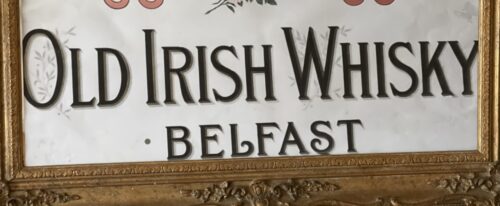
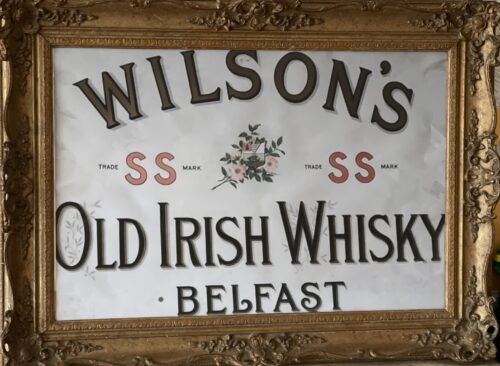


 Some original and rare Mitchell mirrors are still surviving today and can be found in some pubs in and around Belfast today
Some original and rare Mitchell mirrors are still surviving today and can be found in some pubs in and around Belfast today
 Some other examples of Mitchell Mirrors which were mass produced for advertising their products
Some other examples of Mitchell Mirrors which were mass produced for advertising their products








